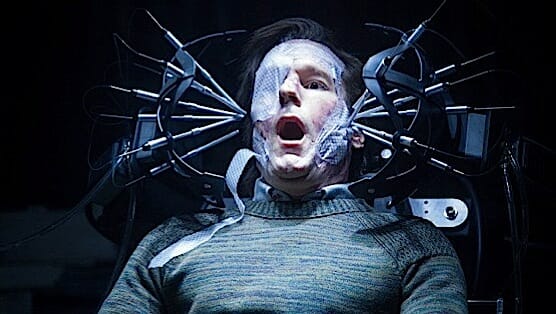Introducing Endless Mode: A New Games & Anime Site from Paste
I never thought I’d see the day when a plotline from Almost Human so strongly recalls one from Parks and Recreation, but … here we are. Last week, the writers introduced the concept of a “Chrome,” or a genetically modified human being blessed with fantastic looks and a long life free of disease. That is, unless someone starts killing them, as is the case with the main villain in “Beholder.” I can’t speak for certain on how long the writers have had this particular concept tucked away in their back pocket, but it certainly seems like a response to those (myself included) who complained that Minka Kelly’s Detective Stahl, who was revealed to be Chrome in last week’s episode, seems designed more as eye candy than a legitimate character. Granted, inordinately attractive woman working in less-than-believable locales is nothing new in TV, but props to theAlmost Human team for at least trying to explain this away.
Anyway, back to the Parks and Rec comparison. In the world of Almost Human, the Chromes live a naturally pampered, high-class life—a far cry from the blue-collar, Blade Runner-esque aesthetic we see from week-to-week. Upon attempting to enter one of Chromes’ fancy clubs, Detective Stahl ends up getting into a bit of a tiff with one of club’s snobbier members. It was here that I suddenly started getting flashes of Leslie Knope and her frequently hilarious encounters with the equally snooty Eagleton officials in Parks and Rec. The fact that the stuck-up woman in question was blonde only intensified the connection.
But enough of that tangent—“Beholder” stands as yet another solid episode from a series that appears to be slowly but steadily figuring out its format. In particular, the writing staff has really stepped up their games when it comes to constructing memorable week-to-week villains. (Granted, the reveal of last week’s villain was a touch problematic, but the general idea of a killer security system was cool enough.) The central antagonist this time around is Eric, a mysterious hooded man with bandages covering his face. Eric’s MO appears to be killing Chromes with distinctive facial features, extracting their genetic info and then forcing a disgraced plastic surgeon (there are certainly a fair share of disgraced doctors, scientists and surgeons in the future) to alter his face based on this information.
The power and tragedy of this particular storyline comes in the reveal of Eric’s ultimate motivations. A more predictable outlet, of course, would be to make him a brutally scarred man looking to restore his face. (The show even includes a plot point about a failed plastic surgery experiments as a red herring.) Instead, the man appears to be suffering from a highly advanced case of body dysmorphic disorder. Though his driver’s license reveals him to be a perfectly handsome individual, Eric sees himself as hideous and deformed. Thus, he sees these surgeries as a way to become his most perfect self. This is particularly important to him since he has been corresponding with a beautiful young woman via the Internet and wants her to see him as beautiful. It’s a nice play on the more popular trope of the girl abusing herself because she doesn’t look as pretty as the woman in magazines, showing that men can equally be corrupted by this notion of “perfection.” This becomes all the more heartbreaking when—oh, cruel irony—Eric’s beloved turns out to be blind.
Unlike recent episodes, “Beholder” doesn’t try to incorporate elements of the show’s larger plotlines. Instead, it focuses on slowly and subtlety developing the characters and their emotional journeys. In the wake of countless episodes where Kennex insists he is a gruff loner, the show’s final scene—wherein the dejected character stares out into the void of the city after discovering Stahl’s new relationship with a fellow Chrome—does a lot to give Urban a more layered character to work with. Even though I feel like the problematic chemistry between Kennex and Stahl ultimately makes this turn feel a tad flatter than it should, Urban’s innate skills as an actor is enough to pick up the slack.
Towards the beginning, Almost Human realized that its appeal resided not in the cold sci-fi-meets-police-drama proceedings of the pilot episode but in how the various characters work, interact and ultimately change one another. With “Beholder,” the writers have again demonstrated that they understand both the show’s strengths and its weaknesses. While the quality of episodes may wax and wane overtime, the most important thing is that audiences are invested in the characters. God willing, Almost Human may just be on its way to achieving that.
Also, I can’t believe I made it all the way through this recap without once referencing the fact that Kennex ends up beating down a chubby woman, who turns out to be Tony Cox—best known as Billy Bob Thorton’s foul-mouthed elf partner in Bad Santa—in a robot suit. This has now been noted. Elaborating would only ruin the fun.
Mark Rozeman is a Los Angeles-based freelance writer and regular contributor to Paste. You can follow him on Twitter.
